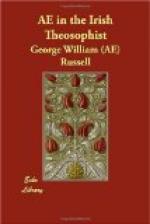The cycles of the Gods is followed in Irish tradition by the cycle of the heroes. The Gods still mingled with them and presumably taught them, for many of these heroes are Druids. Fin, the hero of a hundred legends, Cuchullin, Dairmud, Oisin and others are wielders of magical powers. One of the most beautiful of these stories tells of Oisin in Tir-na-noge. Oisin with his companions journeys along by the water’s edge. He is singled out by Niam, daughter of Mannanan, king of Tir-na-noge, the land of the Gods. She comes on a white horse across the seas, and mounting with her Oisin travels across the ocean; after warring with a giant Fomor he passes into Tir-na-noge, where for a hundred years he lives with Niam and has all that heart could wish for. But desire for Eire arises within him and returning, he falls off the magic steed, and becomes an old man weary with years. It is purely occult. Oisin, Niam, her white steed, Tir-na-noge, the waters they pass over, are but names which define a little our forgotten being. Within Oisin, the magician, kindles the Ray, the hidden Beauty. Let us call it by what name we will, so that we spare the terms of academic mysticism or psychology. It is the Golden Bird of the Upanishads; the Light that lighteth every man; it is that which the old Hermetists knew as the Fair or the Beautiful—for Niam means beauty; it is the Presence, and when it is upon a man every other tie breaks; he goes alone with It, he is a dying regret, an ever-increasing joy. And so with Oisin, whose weeping companions behold him no more. He mounts the white horse with Niam. It is the same as the white horse of the Apocalypse, whereon one sits called Faithful and True. It is the power on which the Spirit rides. Who is there, thinking, has felt freed for a moment from his prison-house, and looking forth has been blinded by the foam of great seas, or has felt his imagination grow kingly in contemplation—he has known its impelling power; the white horse is impatient of restraint.
As they pass over the waters “they saw many wonderful things on their journey—islands and cities, lime-white mansions, bright greenans and lofty palaces.” It is the mirror of heaven and earth, the astral light, in whose glass a myriad illusions arise and fleet before the mystic adventures. Haunt of a false beauty—or rather a veil hung dazzling before the true beauty, only the odour or incense of her breath is blown through these alluring forms. The transition from this to a subtler sphere is indicated. A hornless deer, chased by a white hound with red ears, and a maiden tossing a golden lure, vanishes for ever before a phantom lover. The poet whose imagination has renewed for us the legend has caught the true significance of these hurrying forms:




